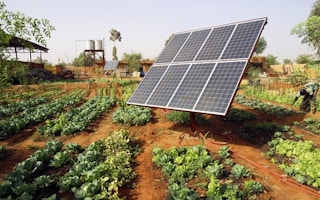Advances in printed solar cell technology promise clean renewable energy, opening possibilities for 1.3 billion people still without electric power in developing countries.
The technology, which only requires the use of existing industrial-size printers, can produce solar cells that are flexible and inexpensive to transport, says Scott Watkins, director of the overseas business unit of Korean firm Kyung-In Synthetic.
The malleable nature of the paper-thin solar cells makes it ideal for rural communities in remote locations, adds Watkins who spoke at the Smart Villages session of the World Conference of Science Journalists in Seoul, South Korea on Monday (8 June).
Existing solar energy technology consists of silicon-based panels which are produced in wafers and require a large amount of sunlight to be efficient. Printed solar cells employ a more organic approach that uses perovskites, a mineral made out of a precise mixture of lead, iodine and a simple organic component.
Interest and research funding in printed solar cell technology has taken off in recent years, resulting to a jump in energy efficiency to 20 per cent from just 3 per cent a few years ago.
However, printed solar cells have been shown to be vulnerable to moisture and may cause lead contamination should the cell break.
Watkins says that his organisation is looking into different types of coaters such as dual-feed spray coaters that allow for more customisable solar prints.
“Printed solar cells have worked very well with Smart Village programmes. I’ve witnessed first-hand how the technology has enabled urban poor communities in India to access off-grid electricity,” says Watkins.
“Its success is due to its cost effectiveness and simplicity. A 10x10 cm solar cell film is enough to generate as much as 10-50 watts per square metre,” he adds.
But some challenges hinder large-scale production and distribution of the technology.
Bernie Jones, project co-leader of the Smart Villages Initiative, notes that although they have almost perfected the method of producing solar film strips at a low cost, replicating the production process requires a large amount of capital.
“Entrepreneurs we’ve engaged cannot afford to invest in the printing machines needed to produce cheap solar strips,” says Jones.
Other problems involve setting up a distribution network, which can be challenging for communities situated in remote areas. Some villages such as the Bario community in Sarawak are only accessible by river, which also opens issues regarding payment and monetary collection, Jones says.
Jones suggests establishing a cooperative system, citing the case of farmers’ cooperatives in Rwanda. He says this may alleviate the issue of distribution while solving the initial problem of securing capital.










